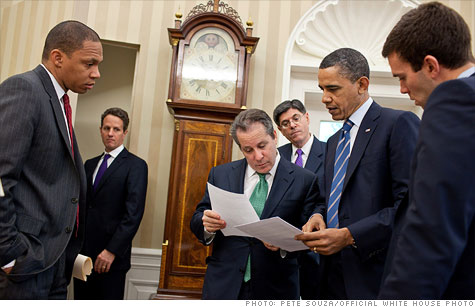
Obama's budget team has more work to do.
NEW YORK (CNNMoney) -- After months of political wrangling, lawmakers have managed to pass a bill that raises the debt ceiling and cuts spending.
Now for the hard part.
Congress cut spending, but still has to decide which programs and agencies will receive less money.
Really, that's where the rubber always meets the road. And the deadline for making those tough choices is just around the corner.
The next fiscal year starts on Oct. 1, and legislators are still light years from putting together a spending plan for next year.
And this new bill -- which cuts spending -- is being dropped into the appropriations process at what amounts to the last minute.
"It's now August," said Craig Jennings, federal fiscal policy director at OMB Watch, which monitors federal spending. "They have to get this done by the end of September, and the Senate hasn't done anything."
Complicating matters is the fact that Congress has to actually cut spending, rather than increase it.
In April, lawmakers set discretionary spending levels at $1.050 trillion for the current fiscal year.
The law President Obama signed Tuesday sets discretionary spending levels for 2012 at $1.043 trillion and at $1.047 trillion for 2013 -- or an accrued total of $10 billion below current levels.
And what is discretionary spending anyhow?
It's a small section of the budget that includes funding for food inspectors, the FBI and education grants, among many other programs and services people associate with government.
But the debt ceiling bill doesn't speak to which agencies or specific programs should bear the brunt. Instead -- it says cut, and cut now.
Meanwhile, a senior senator from the Pacific Northwest will have very different spending priorities than a newly elected House member from Florida, and those differences are highlighted when it's time for the federal government to dole out money.
"Congress still has to do the usual fighting," said Jennings. "They still have to break down spending for each agency, and there are still going to be disputes between the House and Senate."
That sounds an awful lot like what happened with the fiscal 2011 budget, when the normal appropriations process degenerated into a protracted battle that brought the government to the edge of a shutdown.
Congress passed seven short-term stopgap measures called "continuing resolutions" over the course of six months.
Of course, short-term spending bills are nothing new. Congress has enacted at least one every year for all but three of the past 30. But seven in one year was unprecedented, and indicative of partisan gridlock.
The latest will expire on the last day of September, a deadline now just weeks away. Because lawmakers have made such little progress on setting agency funding levels, it now seems a short-term bill is a guaranteed.
Jennings said there is the potential for another food fight -- especially if Republicans consider the spending caps to be a ceiling, rather than the target level of spending.
"If Republicans want to go lower than the caps, they can do that," Jennings said.
| Overnight Avg Rate | Latest | Change | Last Week |
|---|---|---|---|
| 30 yr fixed | 3.80% | 3.88% | |
| 15 yr fixed | 3.20% | 3.23% | |
| 5/1 ARM | 3.84% | 3.88% | |
| 30 yr refi | 3.82% | 3.93% | |
| 15 yr refi | 3.20% | 3.23% |
Today's featured rates:
| Latest Report | Next Update |
|---|---|
| Home prices | Aug 28 |
| Consumer confidence | Aug 28 |
| GDP | Aug 29 |
| Manufacturing (ISM) | Sept 4 |
| Jobs | Sept 7 |
| Inflation (CPI) | Sept 14 |
| Retail sales | Sept 14 |